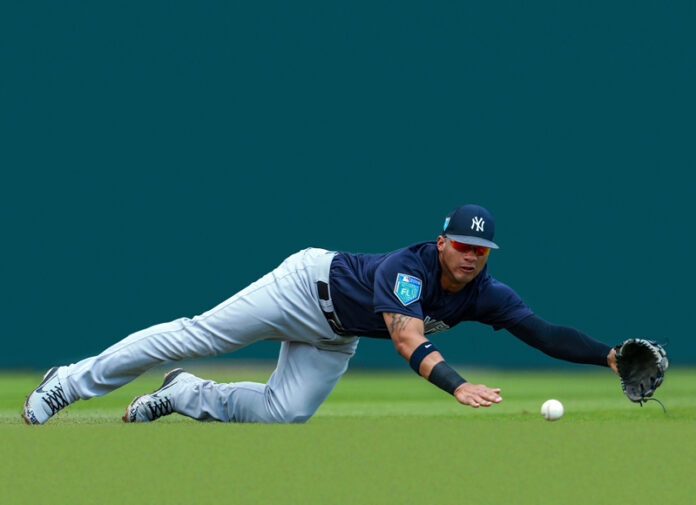with Michael Dill
by Bill Hedrick
Michael Dill has been in the photography business for over 25 years. Like many of us, his interest in photography began when he was just a kid and eventually developed into a passion. In the beginning, Michael made his living with portrait, wedding, and sports photography in New Jersey. At one point, he worked as a freelance photographer for the Trenton Times, covering youth sports, high school, college, minor league baseball, and hockey, along with Major League Baseball, and the NFL covering the Philadelphia Eagles games.
Before long, Michael decided that simply selling sports photographs was not enough, so he developed a trademark style of selling collages of individual players. Area high schools booster clubs took notice and hired him to provide 16×20 framed collages of individual players, something he learned from his mentor, Ralph Romaguera, as gifts to graduating seniors. This became a profitable addition to the custom memory mates he was already providing for all players on the teams.
 Then, about six years ago, the portrait and wedding industry began to change and Michael made a decision to stop photographing weddings and to develop his sports photography. Soon afterwards, he got a lucky break when the Team Photographer for the Trenton Thunder (NY Yankees AA Affiliate) and the Lakewood BlueClaws (Philadelphia Phillies A Affiliate), also a mentor, decided to retire and recommended Michael to replace him. This opened a new chapter in his career that has brought Michael a great deal of recognition in the sports world.
Then, about six years ago, the portrait and wedding industry began to change and Michael made a decision to stop photographing weddings and to develop his sports photography. Soon afterwards, he got a lucky break when the Team Photographer for the Trenton Thunder (NY Yankees AA Affiliate) and the Lakewood BlueClaws (Philadelphia Phillies A Affiliate), also a mentor, decided to retire and recommended Michael to replace him. This opened a new chapter in his career that has brought Michael a great deal of recognition in the sports world.
Although he now resides in Jupiter, Florida, Michael commutes to New Jersey during baseball season. “My season starts in February when I’m covering spring training in Florida,” he explains. “I get workout and action photos of the players who have been with the teams as they progress up the ladder and do many minor league headshots before the season starts. These photographs are done using green screen so that they can be cut out and used on scoreboards as they come to bat and also to be used in the programs.”
Beginning in the month of April, Michael is in New Jersey and focused on building a database of photos of each player, along with game action photos. It is an important month because photos are selected to be used for baseball card sets. “April is also a cold month in the Northeast and you don’t want to get photographs of players with cold weather gear or to show empty seats in the stands, so a lot of my shooting is actually from the stands so I can eliminate the empty seats.”
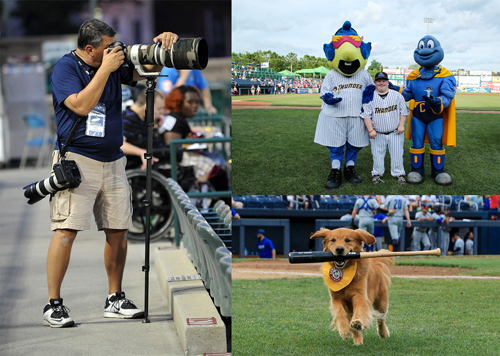
Once those baseball card photos are ready, Michael continues to build the player photo databases. But, as the weather begins to warm up, he also starts concentrating on getting action and reaction shots of the fans themselves. “It is important to note that Minor League Baseball is about the fan experience. So, a lot of festivities happen. It starts with events outside the ballparks as fans come in… fan first pitches on the field, fan experiences on the field between innings, and events in the stands,” says Michael. “Each team has a mascot and the Trenton Thunder have bat dogs, so I focus on getting plenty of images with them.”
When there are sellout crowds, Michael will often go up on a Genie Aerial Lift in center field and shoot the game from there to get a different perspective and to show the crowded stadium in the background. On one occasion, he shot the crowded stadium from a helicopter. Then, as the summer progresses, new players are often added to the roster and Michael will repeat the early season routine of taking headshots and action photos of them as well.
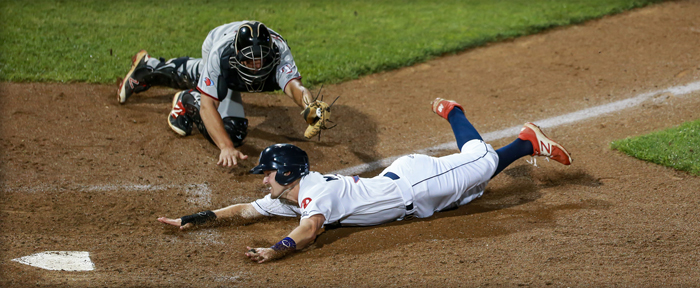
The Minor League season ends on Labor Day and then the playoffs begin. “I’ve been very fortunate to have my teams in the playoffs each year. In 2019, the Trenton Thunder won the Eastern League Championship and Michael received his first championship ring… a special moment in his career. But the friendships he has developed in these organizations and with the players stands out among everything else. “I’ve seen players that I’ve covered in the minors like Aaron Judge, Gary Sanchez, Scott Kingery, and Miguel Andujar make it to the majors and they still remember me when they see me.”
Another very rewarding benefit of being a Team Photographer is the human factor. In Trenton, they have a bat boy named Tommy Smith who has Down Syndrome. “Tommy is so special with the players and fans. When Tim Tebow was playing for Binghamton, he invited Tommy to be their bat boy for the night. In 2019, Tommy was given his night at Trenton when fans received a Tommy Smith Bobblehead. It was a special night,” he recalls. That same year, Michael put together a photo book featuring Tommy Smith to help raise money for the Miracle League of Mercer County.
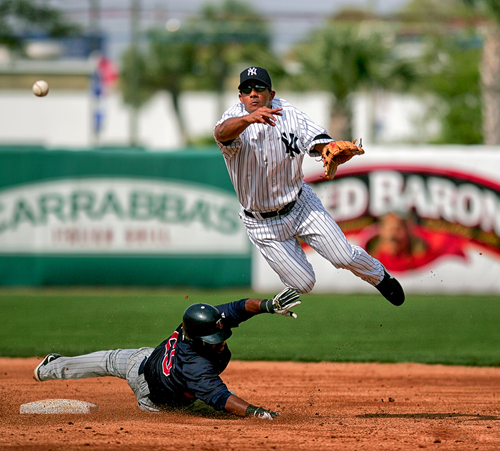
By definition, most photographers are “gadget freaks.” But, along the way, Michael Dill has learned some valuable insight about photographic equipment. “You should always consider purchasing used camera gear from a reputable dealer,” says Michael. “Costs for sports cameras and longer lenses are expensive and you need to be able to make enough money to pay for them.” He advises using a camera with the ability to capture at least 12 frames per second that is designed for action shots.
Long lenses should be at least 300mm to 400mm with an f2.8 aperture for capturing night shots, although a 70-200 f2.8 should be fine for youth sports. To avoid having to change lenses on site, Michael carries up to three cameras with one of them using a 26-70mm f2.8 or 16-35mm f2.8 for getting different types of photos. “Teleconverters can help extend your range but they come at a cost where you lose stops.” Of course, a monopod is a must for any sports photography.
Just as his mentor passed on valuable tips to him, Michael has some for anyone thinking about venturing into the sports photography world. First, he recommends that you really need to know the sport you are photographing. Stopping action and anticipating plays are a must, as well as knowing the rules of the game and observing professional courtesy to other photographers.
Sports photographers need to have a good understanding of exposure, lighting, depth of field, workflow, and camera operation before attempting sports photography. Scouting out a location in advance of a game is highly recommended, especially if it is your first time photographing there.
Another important tip for sports photography is to move around and get different perspectives of a game. Get photographs of batters swinging, pitchers pitching, infielders warming up, and catchers throwing down to second base at the beginning of the inning. “This enables you to get photos of at least six of the starting nine players,” says Michael.
Look for other good shots as well, including shots of the first baseman, players at second base, right-handed pitchers pitching, players at the plate where the catcher is facing you, right-handed batters opening up and pulling the ball, and left-handed batters facing you. Don’t forget shots capturing the pitcher from several different angles. “It’s also good to know ahead of time if your pitchers are right-handed or left-handed so you can properly position yourself.”
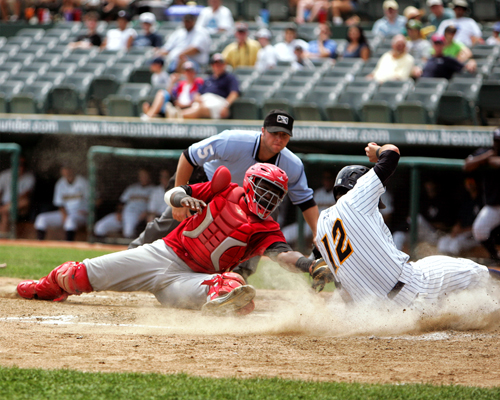
When photographing the outfielders, a longer lens is mandatory except for youth leagues. Be watching for diving catches or leaping the wall for a ball. Optional photographs might include candid photos of players, walk-off situations, player portraits, players in the dugout, equipment in the dugout, conferences at the mound, as well as mascots and fans trying to get autographs.
As the Team Photographer, Michael also gets to know and photograph some prominent Major League Rehab assignments and, along the way, Michael has become acquainted with players like Derek Jeter, Alex Rodriguez, Andy Pettitte, Chase Utley, Dellin Betances, Roger Clemens and and Luis Severino, to name a few, when they came back after injuries. Other opportunities include photographing the Minor League All-Star games, Home Run Derbi, and Championship Series. His photographs are also regularly included in a book that is published yearly by Steve Potter titled, “Phillies Minor League Digest – A Fan’s View.” Some of his images have also appeared on Topps baseball cards and in Yankees Magazine.
The year 2020 has undoubtedly been an exceptionally challenging year for sports. On March 12th, Michael was photographing Yankees/Marlins spring training game on the last day before spring training was cancelled and someone on the field tested positive for COVID-19. “We didn’t know who it was but I had to quarantine.” Shortly afterwards, it became obvious that the season was not going to start on-time. By the month of May, there were no signs of baseball being played anywhere and Michael realized that the Minor League season was in jeopardy. By July, everything had been officially cancelled.
“The sad part is that those players who are nearing their late 20’s could be out of baseball because of this. As for me, it is the first year in 25 years that I’ve gone without photographing baseball, something I’m really missing. It is America’s Pastime.”
 Michael Dill is an internationally recognized, award-winning photographer who runs a successful sports and event and portrait studio in Jupiter, Florida, and Robbinsville, New Jersey. He is a Master Photographer, Photographic Craftsman, and Certified Professional Photographer who boasts an unrivaled passion for his craft. He has also evolved into a dynamic teacher of the trade who conveys his signature techniques and even some industry secrets to his students. Learn more about him at www. michaeldillphotography.com.
Michael Dill is an internationally recognized, award-winning photographer who runs a successful sports and event and portrait studio in Jupiter, Florida, and Robbinsville, New Jersey. He is a Master Photographer, Photographic Craftsman, and Certified Professional Photographer who boasts an unrivaled passion for his craft. He has also evolved into a dynamic teacher of the trade who conveys his signature techniques and even some industry secrets to his students. Learn more about him at www. michaeldillphotography.com.



